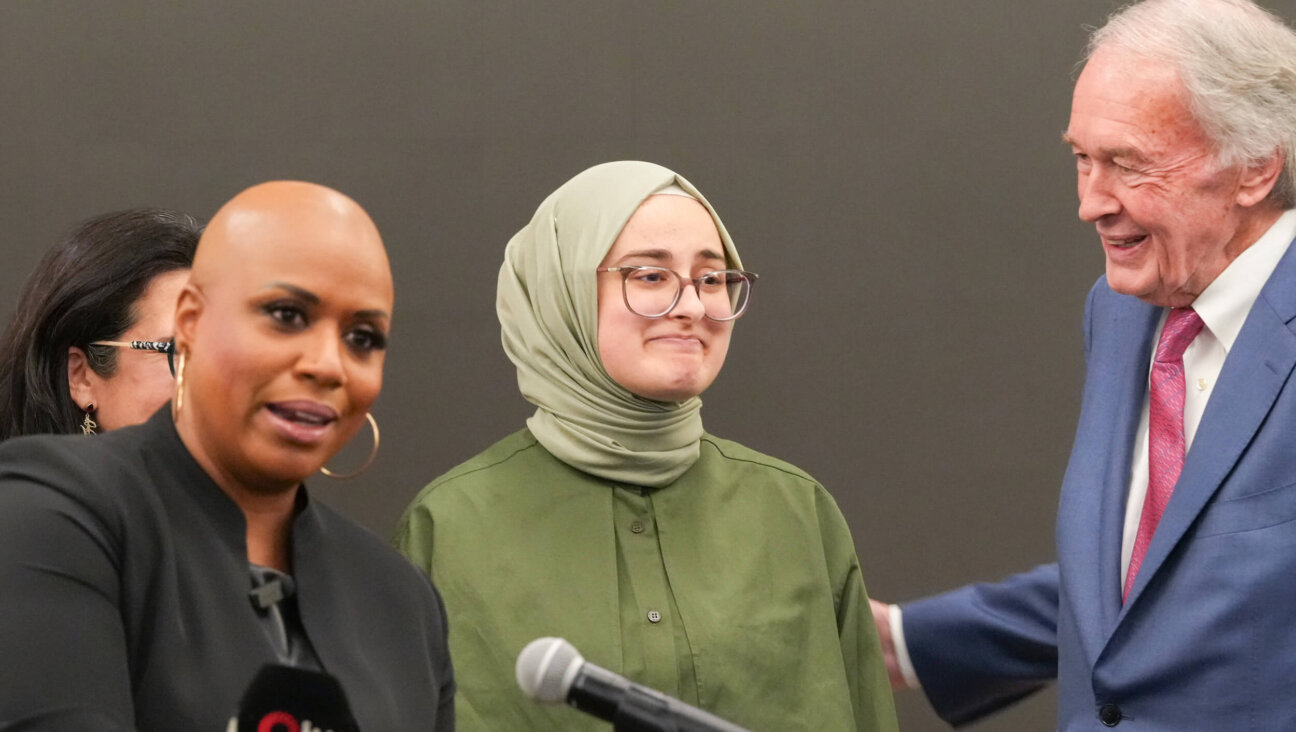Can a Christian theater company put on a good Purim spiel?
I learned about “Queen Esther” from a TV ad. How could I resist going?

Esther is crowned at Sight & Sound’s production of “Queen Esther.” Courtesy of Sight & Sound
In the Purim story, a Jew hides in plain sight among gentiles until the time is right for a big, momentous reveal that, in a miracle of history, saves our people. In late December, when I went to see “Queen Esther,” a big-budget biblical spectacle that puts an evangelical spin on the Megillah, I was one such hidden Jew. And, appropriately for Purim and a pandemic, I was masked.
For me, the only real question was if I would, as Queen Esther did, reveal my Jewishness. That and how, exactly, a Christian production company, known for live animals, technical wizardry and evangelism, would shoehorn Jesus into the one book of the Bible that doesn’t even make an oblique reference to the Hebrew God.
The road to Shushan

The exterior of Sight & Sound Theatre in Lancaster County, PA. The complex is a whopping 150,000-square feet.
Founded in the 1970s by Lancaster, Pennsylvania-based dairy farming couple Glenn and Shirley Eshelman, Sight & Sound grew from a humble operation – underscored, narrated slide projections of Glenn’s photography – to a behemoth with theaters in Strasburg, Pa. and Branson, Mo., staging miracles like the parting of the Red Sea. As of 2022, Sight & Sound Ministries has a conservatory program, a streaming service and claims to entertain over 1 million visitors a year.
I learned about them from a TV ad for “Queen Esther” while I was at my parents’ house in Westchester. In the ad, a veiled woman is carried on a palanquin and taken to be crowned. A portentous voiceover tells us that “everyone has a story,” and we are about to see hers.
How could I resist?
To get to Sight & Sound from where I was crashing with my pal Andy in downtown Lancaster, you drive along a ribbon of country road past stretches of farmland. You pass clotheslines, grain silos, Amish markets, Trump 2024 lawn signs, horses and horse apples. A vaguely Middle Eastern, cupolaed compound winks in the distance. Opposite the theater’s entrance, there’s a guy with a chainsaw; hopefully he’s just there to take care of some sick trees.
In the parking lot, there are charter buses from Massachusetts and Maryland and cars with New York and West Virginia plates. On a red Camry, there’s a license plate frame that reads “Jesus is the Answer.” A white van patterned with black splotches like a cow boasts the painted message that abortion is murder.
It’s about 45 minutes before the 3 p.m. show. Already there are about 100 people milling around a central courtyard fountain with statues of a lion and a lamb (a sign says “Do not climb on the lion, lamb or rocks”).
Inside are beige limestone walls that look vaguely Kotel-ish and palm trees. It’s giving me nicer Medieval Times vibes, but with a biblical theme. Throughout, there is an abundance of Esther merch — snow globes, t-shirts, decorative mirrors all bearing the line “For such a time as this,” the play’s de facto tagline, taken from Mordecai’s words to Esther: “Who knoweth whether thou art come to the kingdom for such a time as this?” Vendors sell glazed almonds (Andy gets some) and “Mr. Sticky’s Famous Sticky Buns.”

Queen Esther: The T-shirt, Queen Esther: The Baseball Cap and (not pictured here) Queen Esther: The Snow Globe and Inscribed Mirror.
The crowd is diverse – I hear some Spanish – and there are a lot of families for a Thursday afternoon. Some people wear masks, omicron is on the uptick, but I am definitely in the minority with my KN95.
A woman next to me in the 2,047-seat auditorium confides that she should probably be wearing her mask, too. She tells me our section, a kind of loge near the exits, between the balcony and orchestra, is a plum seat because it’s near where actors often enter or exit on horseback. She is a regular at Sight & Sound, coming from a few hours away in Haymarket, Va. She loved their take on the Book of Daniel, and knows that story better than Esther’s. Daniel is an important book for Christians, and is often seen as foretelling the coming of Jesus.
The Megillah, on the other hand – a story about a Jewish orphan girl, who is selected as the Persian queen for her beauty and foils the king’s Jew-hating advisor by asserting her heritage – has confounded even Jews for its lack of religious content, causing some Greek translators to write Him in. Many Christians have been even more hostile in their critique.
Martin Luther hated the Book of Esther for its “heathen unnaturalities” and because it “Judaizes too much.” He wished to “toss it into the Elbe” and excise it from the canon. Early church fathers couldn’t be bothered to write major commentaries on it. Theologian Frederic W. Bush called it an “opus non gratam” among mainstream Christendom. Its apparent anti-gentile sentiment and whiff of Jewish nationalism made it something of a deep cut for non-Jews, while its lack of overt religious messaging make it a peculiar candidate for a Christian treatment. So why pick it?

They are apparently quite well-known for their glazed almonds.
The people at Sight & Sound – who at first seemed open to talking, and have since dodged my emails and voicemails – appear to have selected Esther because it is a good, dramatic story. Dan Deal, one of the folks who developed “Queen Esther,” told an interviewer it’s “all about suspense” and is “perfect for the stage.” (If he is aware of the longstanding Jewish precedent of staging the story as an often-satiric Purim spiel, he didn’t mention it.)
Meanwhile, Deal’s creative partner, Kristen Brewer, recognized a possible storytelling challenge from the source text: the whole “no mention of God” bit.
“You have plot twists at every single turn,” Brewer said in a Sight & Sound YouTube video, “and you’re sort of asking — where is God in all this?”
Rabbinic tradition holds that God’s hand was hidden in Esther’s narrative. But most Jews need not be troubled by its lack of prayers or overt divine intervention, recognizing it as perhaps the most fun iteration of the distinctly tribal formula: “they tried to kill us, we survived, let’s eat” (or in this case, drink).
That formulation doesn’t work as gracefully for Christians with an explicitly religious mission. And so, in Deal and Brewer’s hands, the story is, to quote Deal, “about courage to believe that God has a master plan that he works within our faith to bring all things together for His good.” To stress that, the script name-drops God constantly.
Esther becomes much less a savior of her people, and more a humble champion of her faith. But is that faith recognizably Jewish when Sight & Sound approaches it?
To boo or not to boo?
Before the play begins, a projection and voiceover acknowledge that this story has been told “from generation to generation” on the Jewish holiday of Purim. The crowd is invited to “cheer and participate” as is customary. I associate Purim more with jeering than with cheering, but in any case, there are no ushers handing out groggers, or, for that matter, playbills.
The story kicks off with an animation of a scroll. (Megillah means scroll!) Esther’s voice tells us to “pay attention to what you are about to see – don’t miss a moment.”
Massive curtains part behind an ornate, gilded, false proscenium that reminds me a lot of the Broadway “Aladdin,” only in Persia. All the elaborate arches and latticework seem perfectly plastic or machine-made. We are in Susa (Shushan) in the reign of Xerxes (Ahasuerus is a mouthful). And Xerxes – a short dude with a dark beard and wig of long hair – is drinking with his people, decked out in purple and gold robes and accompanied by some kind of Borzoi dog. He’s celebrating the anniversary of Cyrus the Great’s conquest of the land and, in his revels, calls for Vashti to appear before this audience in her crown.
We know what happens next. Vashti, in a crazy spangly outfit – something Cher might wear in a Vegas residency – refuses to come. She reasons that she’s far too royal for such an undignified spectacle. “He is the son of a stable boy! I am a true queen,” she thunders, alluding perhaps to her descent from Nebuchadnezzar, her Jew-exiling great-grandpa.
Leaning into a pedigree argument found in the Midrash Rabbah, this production evades the oft-accepted, and racy, drash of Xerxes’ command – that he meant for Vashti to appear naked, but for her crown. What exact fate awaits Vashti after her defiance is a mystery, but her refusal sets things in motion, as Xerxes now needs a queen.

Esther (Jessica Brown) appeals to God to show her the way.
After this inciting incident, played proscenium-style, the rest of a 300-foot wrap-around stage appears from behind the dark walls to our left and right. It’s an overwhelming street scene of modular moving marble and stone houses with alleyways and terraces. Some can rotate or open and close like pop-up books. The reveal is amazing, yet the crowd, despite being encouraged to “cheer and participate,” doesn’t clap.
Less amazing is this Esther, who we meet as Hadassah, her Hebrew name. Wearing a pink shawl and carrying groceries for a widowed neighbor, she is the model of pious Hebrew duty. (There’s no real feminist reinvention for her or Vashti, I’m afraid – though Xerxes’ mom and Haman’s wife later get some moments to sing, that, nonetheless, pass no Bechdel test.)
After Hadassah’s intro, we see her cousin Mordecai, an older guy with a beard, skullcap and Yiddish inflection. Andy would later describe his performance as a bit too “Fiddler on the Roof.”
For some reason, this Mordecai is an accountant. I choose to believe that this decision comes from Carey A. Moore’s Anchor Bible Commentary, which speculates that he may be the same person as a man named Marduka, mentioned in a cuneiform document as a royal bookkeeper.
Already, God has been mentioned a ton, course-correcting from His curious exclusion. Deal and Brewer have chosen – in a move not out of step with midrash – to make our main characters devout, welcoming the Sabbath with “challah bread” and paraphrasing Isaiah. It’s on account of this strict observance (and no small amount of distaste for Persians) that Mordecai gets very upset when soldiers come to audition Hadassah for the king’s harem. That these soldiers, presumably played by Christians, make a meal out of saying lines like “the king doesn’t want a filthy Jew” does not make me feel great.
Mordecai advises Hadassah to hide her heritage, getting the idea to rename her Esther after he bumps into a child with that name. As Esther passes through the gate, Mordecai turns to face the audience and, in anguish, sings “Remember who you aaaaare.”
Around this point, I remember that I am probably the only Jew in a space not meant for me, watching a story about my people as performed by a troupe that feels the need to tag on “bread” to the word “challah.” I decide that my presence gives the room a negligible air of authenticity and opt, with some hesitation, to do what I was programmed to since toddlerhood.
When one of the king’s advisors says “send for governor Haman,” I boo through my mask. No one reacts. The crowd is none too responsive to anything. But Xerxes, distressed about the state of his kingdom, does respond well to Esther, who plays the harp for him and calms his frayed nerves.

Esther rides atop an elephant puppet during her coronation. The giftshop had plenty of elephant hobby horses for kids to replicate this scene,
Esther becomes queen. Things are going well for our heroes until Haman, dressed in red and looking a little like Jafar, enters the picture. I boo and hiss. Mordecai has a conniption when he hears that Haman is a “self-declared Agagite,” receiving it much like a contemporary Jew might greet the news that Steve Bannon is Trump’s chief strategist.
Mordecai explains the significance of the enemy Agagites (a word only found in the Megillat Esther) accompanied by animation of King Saul and the fall of man. He sings “Generation to generation, the echo rings: Our history of blood and kings.”
He and Haman, inheritors of this history, are set for a collision course and we wonder whether Mordecai will bow to him, or risk his ire. It’s a pretty silly cliffhanger when presented this momentously.
Exit Haman, enter Jesus
At intermission, Andy and I discuss what battle exactly Xerxes was trounced at. Was it the one from “300?” To our right is a family of women who came from Queens. They say they knew I was from New York because I too was wearing a mask. They don’t really know the Esther story, but are enjoying it.
Am I? It’s kinda cool. It definitely drags in places and the songs kinda sound like Stephen Schwartz rejects. The lyrics dare to rhyme “light,” “right” and “tonight.” And I could have lived without the anachronistic quoting of James 4:17 from the character of Ezra the scribe (I think he’s supposed to be Ezra of the Book of Ezra fame, who was a scrivener and worked for Xerxes’ kid). Still, it hasn’t departed too much from the source material.
When the action resumes, a chorus monotonously chants “It’s all at stake, will you bend or break?” to Mordecai as he and Haman march dramatically toward one another at the palace gate.
“Now is the time to bow, don’t ask about how,” the masses exhort.
Staring down Haman, Mordecai declares “I worship the Lord alone” and – look at that – people cheer and clap, and one guy says “amen.”

A section of the wraparound stage at intermission. The lanterns were part of a moonlit stroll Esther and Xerxes had during their love duet.
This defiance ticks off Haman, who hatches his genocidal plan, the date picked by his wife, Zeresh. “On the 13th of Adar, they’ll run but won’t get far,” she sings after rolling some dice.
A little over an hour in, we’re at the crux of the Purim story, embellished here with pseudo-military history and songs that at worst sound improvised and at best are tedious. The performances are just a notch above a typical JCC or synagogue spiel. But the play is surprisingly well-attuned to the concept of ethnic antisemitism, even as it flounders on the way Jews would probably behave. (I don’t think Mordecai would refer to himself as a member of “the people of Jehovah.”)
It’s understood that Haman doesn’t just want Jews dead for what they believe. Though perhaps his beef hinges more on the whole ancestral “history of blood and kings” feud than is necessary.
Mordecai is a hero, paraded on a horse, if a touch too “City Slickers” for my taste, when his service to the king is remembered. But the play wants us to know that he is a hero more for his unfailing, rigid, and – at first – assimilation-resistant zeal than his actions to save his people. His refusal to bow is the main thing.
Esther listens to Mordecai and fails to request her people’s deliverance at the first banquet for Haman and Xerxes. She gets there in the end, finding her courage after a lot of singing to God for guidance. Xerxes is appalled to learn that Haman acted against the Hebrews his grandfather liberated, telling him “You always wanted to be raised up – well, now is your time!”

Esther reveals her identity.
After Haman goes toward the gallows he meant for Mordecai (and we skip the problematic mass murder of gentiles by Jews in chapter nine), Esther sings a worship ballad about how we are not alone and God’s with us. In this case literally.
As she summarizes her story and its lessons, a figure appears on a balcony behind her: young, bearded, robed.
That’s J-man, coming in for the 11 o’clock number. And that might be fine and expected – if profoundly weird if you don’t believe Jesus existed for another 500 years. But then Esther, in a sea of fog and joined by the entire company onstage, raises her hands and sings that there is a “a name stronger still than death or pain,” and then she violates the ultimate Jewish taboo.
She says what that name is: The tetragrammaton – the four letter name of God. On a stage in rural Pennsylvania and not the Holy of Holies on Yom Kippur in the Temple in Jerusalem as intoned by the High Priest. Belted, not spoken quietly. God made explicit, in a fashion that sums up the Sight & Sound approach to the text: why be subtle when you can say the quiet parts out loud?
I am now decidedly offended. After being spurned and reviled for so long in the Christian tradition, Esther earned a lavish chance to grace a Christian venue, and this is how they choose to end it. Well, not quite. After the show, in lieu of a curtain call, the actor who plays Ezra tells us that the same God that was with the people then is with us now and invites us to chat with some of their people in the lobby about living a life with Jesus Christ.
I decide that I’ll pass. Esther didn’t stick her neck out for my people just so some ushers could pray for my conversion.
The real meaning of the story
As I collect my coat, I give more thought to what Esther might think of what I just sat through.
Assuming somehow she understood contemporary English, would she appreciate the very real risks she took being reduced to a blind trust in God? There’s no real way to know, but to my mind, God’s apparent absence in the original story makes it richer, and Esther’s actions braver and imbued with greater agency.
As Dan Deal recognized, Mordecai’s maneuvers, and the stunning reversal that hoists Haman by his own 50-cubit gallows, make this the most cogent story in the Tanakh. It’s also a story where people who would seem to be removed from God – away from His capital and not invoking His name – nonetheless triumph amid a hostile nation through ingenuity and courage. That’s what makes the story Jewish, and Jews don’t need to shout “God” to the rafters to know He’s there.
The upshot is this: They tried to kill us, we survived – a big help you were, God – let’s eat the bad guy’s hat and drink until we can’t tell the difference between him and the hero. Chag Purim sameach, and congrats on almost certainly having a better (if less extravagant) spiel than the one at Sight & Sound.
The Forward is free to read, but it isn’t free to produce

I hope you appreciated this article. Before you go, I’d like to ask you to please support the Forward.
Now more than ever, American Jews need independent news they can trust, with reporting driven by truth, not ideology. We serve you, not any ideological agenda.
At a time when other newsrooms are closing or cutting back, the Forward has removed its paywall and invested additional resources to report on the ground from Israel and around the U.S. on the impact of the war, rising antisemitism and polarized discourse.
This is a great time to support independent Jewish journalism you rely on. Make a gift today!
— Rachel Fishman Feddersen, Publisher and CEO
Support our mission to tell the Jewish story fully and fairly.
Most Popular
- 1

Fast Forward Ye debuts ‘Heil Hitler’ music video that includes a sample of a Hitler speech
- 2

Opinion It looks like Israel totally underestimated Trump
- 3

Culture Is Pope Leo Jewish? Ask his distant cousins — like me
- 4

Fast Forward Student suspended for ‘F— the Jews’ video defends himself on antisemitic podcast
In Case You Missed It
-

News In Edan Alexander’s hometown in New Jersey, months of fear and anguish give way to joy and relief
-

Fast Forward What’s next for suspended student who posted ‘F— the Jews’ video? An alt-right media tour
-

Opinion Despite Netanyahu, Edan Alexander is finally free
-

Opinion A judge just released another pro-Palestinian activist. Here’s why that’s good for the Jews
-
Shop the Forward Store
100% of profits support our journalism
Republish This Story
Please read before republishing
We’re happy to make this story available to republish for free, unless it originated with JTA, Haaretz or another publication (as indicated on the article) and as long as you follow our guidelines.
You must comply with the following:
- Credit the Forward
- Retain our pixel
- Preserve our canonical link in Google search
- Add a noindex tag in Google search
See our full guidelines for more information, and this guide for detail about canonical URLs.
To republish, copy the HTML by clicking on the yellow button to the right; it includes our tracking pixel, all paragraph styles and hyperlinks, the author byline and credit to the Forward. It does not include images; to avoid copyright violations, you must add them manually, following our guidelines. Please email us at [email protected], subject line “republish,” with any questions or to let us know what stories you’re picking up.















